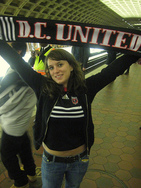A DC United stadium is likely to be truly urban
Last week, Erik posted that DC United is in discussions about small sites in the District for a 20-25,000 seat soccer stadium. The constraints of both Buzzard Point and the Florida Market sites guarantee that the stadium would be a celebrated urban stadium rather than a mini-FedEx Field.
In February 2009, I outlined characteristics of a successful urban stadium. Either of the sites would meet all 6 of those criteria.
Whenever stadium discussions come up, financing is one of the first subjects to be broached. It’s no secret that the District of Columbia is having fiscal challenges, just like most other local governments.
DC United’s ownership would have to pay for a new stadium, similar to how the Washington Wizards ownership paid for constructing the Verizon Center. Without government subsidies (outside of sewage access) the team ownership would be as cost-conscious as possible and still provide a good fan experience.
No surface parking
Parking garages are extremely expensive. Neither Buzzard Point nor the Florida Market have the space for acres of RFK-style surface parking. Without any government support in the form of road building or eminent domain, it wouldn’t make fiscal sense for DC United’s ownership to spend lots of its own money on parking structures when both sites are proximate to Metro stations.
It took government intervention back in the late 1950’s to subsidize building all the parking lots at RFK Stadium. Other un-urban stadiums like Detroit’s Ford Field took government support in the form of zoning and road building. Neither DC United site would require altering the existing street grid and both sites appear to be selected because they wouldn’t require road costs to the District.
Integration with the street grid
Because the District has no interest in offering subsidies in the form of rebuilding streets, the new soccer stadium would have to be designed around existing infrastructure. The celebrated human-scale L’Enfant Plan would be largely undisturbed.
Proximate transit access
The Florida Market site is a five minute walk from the NY Avenue Metro station on the Red Line. The Buzzard Point site is a 10-15 minute walk from the Waterfront and Navy Yard stations on the Green Line.
Pedestrian-friendly connection to transit
South Capitol Street is too wide in places with too-fast traffic. However, it is safe to cross at M St. because the faster traffic is in a trench. The walk from the Waterfront station down Delaware Ave. SW and 2nd St. SW is very safe. They are small neighborhood streets with 25 mph speed limits. The Florida Market site is along Florida Avenue NE. It’s a little wide but the there is enough activity to slow down the traffic. It’s not a suburban arterial or a partially grade-separated street.
Frequency of events
Between its Major League Soccer regular season games, U.S. Open Cup, CONCACAF (North American) Championships, and friendlies, DC United holds approximately 30 games during the season. Other events would want to use the facility too, such as the U.S. National Men’s and Women’s soccer teams, concerts, college sports, other pro sports, etc. 60 events a year is a reasonable estimate. The schedule for the Los Angeles Galaxy’s soccer stadium, the Home Depot Center illustrates the diversity of events held.
Vibrant surrounding urban area
The Florida Market site is within close proximity to the H Street, NE nightlife area. The coming streetcar on H Street will better connect the stadium with existing popular restaurants and bars.
On the other hand, Buzzard Point is a largely forgotten corner of the city. It’s been cut off by I-395 since the 1960’s. Because of its remote location, it would be politically easier to build there because of the lack of potential anti-neighbors. This location represents an opportunity to bring attention and real estate demand to a forgotten corner of the city.
The Buzzard Point site has many things in common with the area around the Navy Yard Metro before the construction of Nationals Park in Near Southeast. While the area surrounding the baseball stadium hasn’t magically become Dupont Circle, it is no longer forgotten. Real estate demand near the Navy Yard Metro is now far greater than before it hosted the ballpark.
The main thing holding it back from progressing towards its potential is the tight global financial environment. While I’m not a baseball fan and think the District got a bad deal on the financing of Nationals Park, I think it’s unfair to say that the redevelopment of the stadium’s surrounding environs “failed.” The redevelopment process is going to take years and will ultimately be for the better.
Looking back into history, some of the best pre-WWII stadiums in the United States also displayed excellent urbanism. They added a sense of place to their surroundings and were considered jewels in their cities. Those great stadiums were built under similar circumstances to a new DC United stadium; they received little government support. They had to use existing infrastructure and squeeze their footprint into existing city blocks. In both the pre-war stadiums and a new DC United stadium, necessity is the mother of invention.
Disclosure: I’m a member of Barra Brava an iconic independent DC United supporters’ group.

